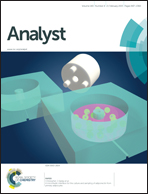A “turn-on” fluorescent sensor for ultrasensitive detection of melamine based on a new fluorescence probe and AuNPs†
Abstract
In this study, we synthesized a new fluorescence probe which was used to detect melamine by coupling with gold nanoparticles (AuNPs). The new fluorescence probe has good optical stability and high fluorescence intensity, which can greatly improve the detection sensitivity. Compared to the traditional fluorophore, it is less dependent on the pH value. It has a very strong fluorescence emission peak at 550 nm, which has larger overlap with the absorption peak of AuNPs. When the probe incubates with the AuNPs, the fluorescence of the probe can be effectively quenched by AuNPs. Adding melamine into a probe–AuNPs mixture caused aggregation of AuNPs and released the adsorbed probe; the fluorescence intensity of the probe was recovered. By measuring the changes of the fluorescence intensity of the probe, the detection of melamine can be realized. Under optimized conditions, the linear response to melamine is in the range of 1.0 × 10−8–4.0 × 10−6 mol L−1 and lowers the detection limit down to 3.0 nmol L−1 with the sensor. This method can detect melamine in milk and milk-based productions.


 Please wait while we load your content...
Please wait while we load your content...